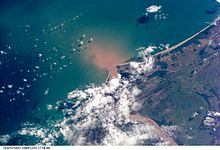- Doce River
-
Doce River at Governador Valadares.

The Doce River (literally the "sweet river"; Rio Doce in Portuguese) is a river in southeast Brazil, which has an extension of 853 km. It is formed by the junction of the Piranga and the Carmo near the historical city of Ouro Preto, whose sources are located in the foothills of the Mantiqueira and Espinhaço mountain chains at altitudes of about 1,200 meters. It flows in a northeastern direction via Ipatinga, makes a wide curve near Governador Valadares, and flows in a southeastern direction passing through Conselheiro Pena, to enter the Atlantic Ocean near Linhares in Espírito Santo state. Its main tributaries are the Piracicaba, Casca, Matipó, Caratinga-Cuieté, Manhuaçu, Santo Antônio and Suaçuí Grande, in Minas Gerais; the Pancas, Guandu, and São José, in Espírito Santo.
The Doce river has great economic importance for the region. The basin is home to the largest steel making complex in Latin America. Three of the five largest companies in Minas Gerais state in the year 2000, Companhia Siderúrgica Belgo Mineira, Arcelor Mittal (Acesita) and Usiminas, are located there. The largest open-pit mine in the world is operated in the basin by the Companhia Vale do Rio Doce. These industrial conglomerates have an important role in Brazilian exports of iron ore, steel, and cellulose (Cenibra). In addition, the Doce basin contributes greatly to production of coffee from Minas Gerais and Espírito Santo as well as fruit pulp from Espírito Santo.
Fifteen percent of the GDP of the state of Minas Gerais is produced in the region with the municipality of Ipatinga accounting for 5.4% of that total. Ipatinga is the major city of the Vale do Aço Metropolitan Area.
The economy of the basin is based on the following activities:
- agriculture: dairy and beef cattle, pig raising, coffee, sugar cane, fruits and vegetables and cocoa;
- industry: siderurgy, metallurgy, mechanical, chemical, food, alcohol, textile, leather, paper and paper pulp; and
- mining: iron, gold, bauxite, manganese, and precious stones.
According to the Anuário Estatístico do Brasil (IBGE) the Doce basin has a population of about 3,100,000, with the urban population making up 68.7% of the total population. In recent years the population has declined, with small towns and rural areas losing up to 40% of their population.
Major cities located along the Doce or in its basin are: Timóteo, Coronel Fabriciano, Ipatinga, Governador Valadares, Colatina, and Linhares.
According to the Koppen classification, there are three climatic types in the Doce basin:
- Tropical with altitude climate with summer rains and cool summers, present on the slopes of the Mantiqueira and the Espinhaço Mountains and at the sources of the Doce river.
- Tropical with altitude climate with summer rains and hot summers, present at the sources of its tributaries.
- Hot climate with summer rains, present in the middle and lower sections of the Doce and its tributaries.


Panorama of the Queimada Bridge over the Doce River, Doce River State Park, Pingo-d'Água. External links
Categories:- Minas Gerais geography stubs
- Rivers of Espírito Santo
- Rivers of Minas Gerais
Wikimedia Foundation. 2010.


